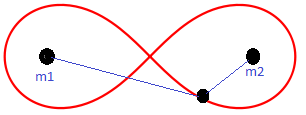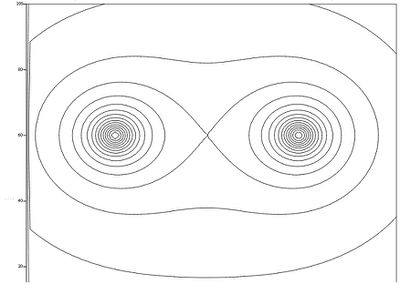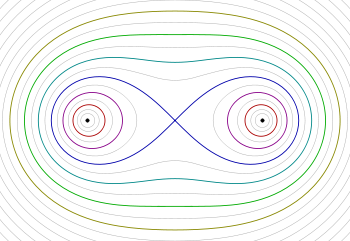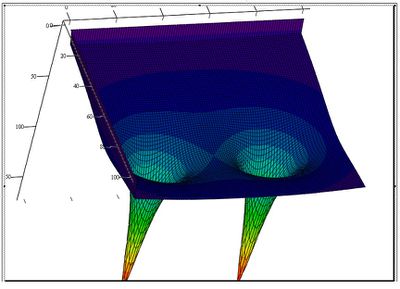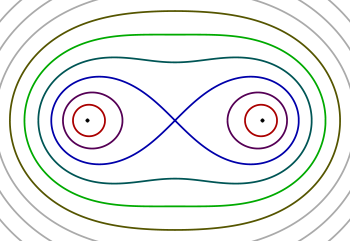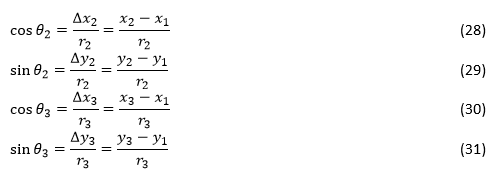КП: Движение спутника в двойной системе
Курсовой проект по Теоретической механике
Исполнитель: Мущак Никита
Группа: 09 (23604)
Семестр: весна 2015
Содержание
Аннотация проекта
Данный проект посвящен изучению движения спутника в двойной системе под действием гравитации. В ходе работы над проектом была написана программа, которая моделирует процесс движения спутника. Программа написана на языке JavaScript.
Формулировка задачи
Исследовать движение спутника двойной системы под действием гравитационной силы. Двойная система состоит из 2 неподвижных планет и спутника вращающегося вокруг них как показано на рисунке сверху. Определить стационарные орбиты спутника, а также устойчивость движения спутника.
Общие сведения по теме
Задачи подобного рода можно решать разными способами. Но решать данную задачу будем 2 способами :
с помощью уравнения Лагража 2-ого рода и как упрощенная задача 3-х тел
1 способ: уравнение Лагранжа 2-ого рода:
,где L - функция Лагранжа (лагранжиан),q- обобщенная координата, t — время, i— число степеней свободы механической системы
Функцию Лагранжа будем считать как разность кинетической и потенциальной энергий системы.
Дальнейшим дифференцированием получаем уравнение движения.
2 способ: записываем 2-ой закон Ньютона для данной задачи и получаем:
, где G- гравитационная постоянная,m- массы планет.
Решение
Ланранжиан будет иметь вид:
![]() , где m - масса спутника, q - обобщенная координата,
, где m - масса спутника, q - обобщенная координата,
![]() - потенциал гравитационного поля.
- потенциал гравитационного поля.
Подставляя полученное выражение в уравнение Лагранжа, можно получить уравнение движения:
![]()
Как можно заметить из уравнения движения масса спутника никак не влияет на траекторию.
Отдельного рассмотрения заслуживает конфигурация потенциального гравитационного поля.
При этом графики такого поля будут выглядеть:
Стационарные орбиты спутника будут близки к овалам Кассини
-это семейство кривых, которые задаются уравнением ![]() , где 2c-расстояние между фокусами, а- некоторая константа.
, где 2c-расстояние между фокусами, а- некоторая константа.
Частным случаем овалов Кассини является лемниската Бернулли, которая выглядит как знак бесконечности или восьмерка
Программа: скачать
Файл "K3.html"
1 <!DOCTYPE html>
2
3 <html>
4 <head>
5 <meta charset="utf-8" />
6 <meta http-equiv="X-UA-Compatible" content="IE=Edge" /> <!-- For IE on an intranet. -->
7 <title>Moon in Binary System</title>
8 <style>
9 html, body {
10 margin: 0;
11 padding: 0;
12 }
13
14 html {
15 overflow-y: scroll; /* There's an issue with the scrollbar "randomly" appearing - this just keeps it always visible in case the user is using a very wide and narrow monitor. */
16 }
17
18 body {
19 width: 1024px; /* Currently, most screens can handle this. */
20 margin: auto; /* Center the page content. */
21 background-color: #777;
22 font-family: "Segoe UI", Tahoma, Geneva, Verdana, sans-serif; /* Start screen font. */
23 }
24
25 header {
26 color: #FFF;
27 text-shadow: 5px 5px 10px #333;
28 }
29
30 section {
31 position: relative; /* Float children relative to this element. */
32 }
33
34 section form {
35 width: 210px; /* This is a bit less than the "section #WebGLCanvasElementContainer margin-left" value to provide a nice space between the form and the viewport. */
36 float: left;
37 text-align: center; /* Center the button elements. */
38 }
39
40 section form fieldset {
41 text-align: left; /* Undo the button center aligning trick for the text in the form. */
42 margin-bottom: 1.25em; /* Adjust this so that the height of the form is about the same height as the WebGL Three.js viewport element. */
43 }
44
45 section form fieldset input {
46 width: 100%;
47 }
48
49 section form td {
50 white-space: nowrap; /* Don't let words like "x-position" break at the hyphen (which occurs in Chrome). */
51 }
52
53 section #WebGLCanvasElementContainer {
54 border: 1px solid #DDD; /* Match the native color of the fieldset border. */
55 width: 800px; /* The assumed fixed width of the WebGL Three.js viewport element. */
56 height: 600px; /* The assumed fixed height of the WebGL Three.js viewport element. */
57 margin-left: 224px; /* This is "body width" minus "section #WebGLCanvasElementContainer width" or 1024px - 800px = 224px. */
58 background-image: url('starField.jpg'); /* 0.15 opacity value. */
59 }
60
61 section article {
62 padding: 0 1em;
63 color: white;
64 }
65
66 section button {
67 width: 4.5em;
68 }
69 </style>
70 <script>
71 /*// Preload all images/bitmaps.
72 var preloadImages = [];
73 var preloadImagePaths = ["jupiter.png", "saturn.png", "moon.png", "starField.jpg", "starField.jpg"];
74
75 for (var i = 0; i < preloadImagePaths.length; i++) {
76 preloadImages[i] = new Image();
77
78 preloadImages[i].onerror = function() {
79 if (console) {
80 console.error(this.src + " error.");
81 } // if
82 }; // onerror
83
84 preloadImages[i].src = preloadImagePaths[i]; // Preload images to improve perceived app speed.
85 } // for
86 */</script>
87 </head>
88
89 <body>
90 <header>
91 <h1>Moon in Binary System </h1>
92 </header>
93 <section>
94 <form id="initialConditions">
95 <fieldset>
96 <legend>Moon</legend>
97 <table id="mass1">
98 <tr>
99 <td>mass:</td>
100 <td><input id="m1_mass" type="number" value="1E18" required="required" /></td>
101 </tr>
102 <tr>
103 <td>x-position:</td>
104 <td><input id="m1_position_x" type="number" value="-141" required="required" /></td>
105 </tr>
106 <tr>
107 <td>y-position:</td>
108 <td><input id="m1_position_y" type="number" value="0" required="required" /></td>
109 </tr>
110 <tr>
111 <td>x-velocity:</td>
112 <td><input id="m1_velocity_x" type="number" value="0" required="required" /></td>
113 </tr>
114 <tr>
115 <td>y-velocity:</td>
116 <td><input id="m1_velocity_y" type="number" value="2" required="required" /></td>
117 </tr>
118 <tr style="display: none;">
119 <td>bitmap:</td>
120 <td><input type="text" value="moon.png" required="required" /></td>
121 </tr>
122 </table>
123 </fieldset>
124 <fieldset>
125 <legend>1st star</legend>
126 <table id="mass2">
127 <tr>
128 <td>mass:</td>
129 <td><input type="number" value="1E19" required="required" /></td>
130 </tr>
131 <tr>
132 <td>x-position:</td>
133 <td><input type="number" value="-100" required="required" /></td>
134 </tr>
135 <tr>
136 <td>y-position:</td>
137 <td><input type="number" value="0" required="required" /></td>
138 </tr>
139 <tr>
140 <td>x-velocity:</td>
141 <td><input type="number" value="0" required="required" /></td>
142 </tr>
143 <tr>
144 <td>y-velocity:</td>
145 <td><input type="number" value="0" required="required" /></td>
146 </tr>
147 <tr style="display: none;">
148 <td>bitmap:</td>
149 <td><input type="text" value="jupiter.png" required="required" /></td>
150 </tr>
151 </table>
152 </fieldset>
153 <fieldset>
154 <legend>2nd star</legend>
155 <table id="mass3">
156 <tr>
157 <td>mass:</td>
158 <td><input type="number" value="1E19" required="required" /></td>
159 </tr>
160 <tr>
161 <td>x-position:</td>
162 <td><input type="number" value="100" required="required" /></td>
163 </tr>
164 <tr>
165 <td>y-position:</td>
166 <td><input type="number" value="0" required="required" /></td>
167 </tr>
168 <tr>
169 <td>x-velocity:</td>
170 <td><input type="number" value="0" required="required" /></td>
171 </tr>
172 <tr>
173 <td>y-velocity:</td>
174 <td><input type="number" value="0" required="required" /></td>
175 </tr>
176 <tr style="display: none;">
177 <td>bitmap:</td>
178 <td><input type="text" value="saturn.png" required="required" /></td>
179 </tr>
180 </table>
181 </fieldset>
182 <button id="submitButton">Submit</button>
183 <button id="reloadButton">Reload</button>
184
185 </form>
186 <div id="WebGLCanvasElementContainer">
187 <!-- Three.js will add a canvas element to the DOM here. -->
188 <!-- The following <article> element (along with its content) will be removed via JavaScript just before the simulation starts: -->
189 <article>
190 <h2></h2>
191 <p>
192
193 </p>
194 <h2>Running the simulation</h2>
195 <ul>
196 <li>To start the simulation with the current set of initial conditions, click the <strong>Submit</strong> button.</li>
197 <li>To orbit, left-click and drag the mouse.</li>
198 <li>To pan, right-click and drag the mouse.</li>
199 <li>To zoom, roll the mouse wheel.</li>
200 <li>To enter your own initial conditions, enter numeric values of your choice (in the form to the left) and click <strong>Submit</strong>.
201 Note that large values such as 10<sup>18</sup> can be entered as 1E18.</li>
202 <li>To restart the simulation from scratch, click the <strong>Reload</strong> button (equivalent to refreshing the page).</li>
203 <li>For additional information and resources, click the <strong>Info</strong> button.</li>
204 </ul>
205 </article>
206 </div>
207 </section>
208 <script src="https://rawgithub.com/mrdoob/three.js/master/build/three.js"></script> <!-- The "CDN" for Three.js -->
209 <script src="https://rawgithub.com/mrdoob/three.js/master/examples/js/controls/OrbitControls.js"></script> <!-- Allows for orbiting, panning, and zooming. -->
210 <script>
211 var DENSITY= 1.38E14; // This value determined qualitatively by observing how large the spheres look onscreen (i.e., their radii).
212
213 document.getElementById('submitButton').addEventListener('click', handleSubmitButton, false);
214 document.getElementById('reloadButton').addEventListener('click', handleReloadButton, false);
215
216
217 var simulation = Simulation(); // Call the Simulation constructor to create a new simulation object.
218
219 function Simulation() { // A constructor.
220 var that = {}; // The object returned by this constructor.
221 var worker; // Will contain a reference to a fast number-chrunching worker thread that runs outside of this UR/animation thread.
222 var requestAnimationFrameID = null; // Used to cancel a prior requestAnimationFrame request.
223 var gl = {}; // Will contain WebGL related items.
224
225 gl.viewportWidth = 800; // The width of the Three.js viewport.
226 gl.viewportHeight = 600; // The height of the Three.js viewport.
227
228 gl.cameraSpecs = {
229 aspectRatio: gl.viewportWidth / gl.viewportHeight, // Camera frustum aspect ratio.
230 viewAngle: 50 // Camera frustum vertical field of view, in degrees.
231 };
232
233 gl.clippingPlane = {
234 near: 0.1, // The distance of the near clipping plane (which always coincides with the monitor).
235 far: 1000 // The distance of the far clipping plane (note that you get a negative far clipping plane for free, which occurs at the negative of this value).
236 };
237
238 gl.quads = 32; // Represents both the number of vertical segments and the number of horizontal rings for each mass's sphere wireframe.
239
240 gl.renderer = window.WebGLRenderingContext ? new THREE.WebGLRenderer({ alpha: true }) : new THREE.CanvasRenderer({ alpha: true }); // If WebGL isn't supported, fallback to using the canvas-based renderer (which most browsers support). Note that passing in "{ antialias: true }" is unnecessary in that this is the default behavior. However, we pass in "{ alpha: true }" in order to let the background PNG image shine through.
241 gl.renderer.setClearColor(0x000000, 0); // Make the background completely transparent (the actual color, black in this case, does not matter) so that the PNG background image can shine through.
242 gl.renderer.setSize(gl.viewportWidth, gl.viewportHeight); // Set the size of the renderer.
243
244 gl.scene = new THREE.Scene(); // Create a Three.js scene.
245
246 gl.camera = new THREE.PerspectiveCamera(gl.cameraSpecs.viewAngle, gl.cameraSpecs.aspectRatio, gl.clippingPlane.near, gl.clippingPlane.far); // Set up the viewer's eye position.
247 gl.camera.position.set(0, 450, 0); // The camera starts at the origin, so move it to a good position.
248 gl.camera.lookAt(gl.scene.position); // Make the camera look at the origin of the xyz-coordinate system.
249
250 gl.controls = new THREE.OrbitControls(gl.camera, gl.renderer.domElement); // Allows for orbiting, panning, and zooming via OrbitsControls.js by http://threejs.org. For an example, see http://threejs.org/examples/misc_controls_orbit.html.
251
252 gl.pointLight = new THREE.PointLight(0xFFFFFF); // Set the color of the light source (white).
253 gl.pointLight.position.set(0, 250, 250); // Position the light source at (x, y, z).
254 gl.scene.add(gl.pointLight); // Add the light source to the scene.
255
256 gl.spheres = []; // Will contain WebGL sphere mesh objects representing the point masses.
257
258 var init = function (initialConditions) { // Public method, resets everything when called.
259 if (requestAnimationFrameID) {
260 cancelAnimationFrame(requestAnimationFrameID); // Cancel the previous requestAnimationFrame request.
261 }
262
263 if (worker) {
264 worker.terminate(); // Terminate the previously running worker thread to ensure a responsive UI.
265 }
266 worker = new Worker('K3.js'); // Spawn a fast number-chrunching thread that runs outside of this UR/animation thread.
267
268 document.getElementById('WebGLCanvasElementContainer').style.backgroundImage = "url('starField.jpg')"; // Switch back to the non-opaque PNG background image.
269 document.getElementsByTagName('article')[0].style.display = "none"; // Remove from page-flow the one (and only) article element (along with all of its content).
270 document.getElementById('WebGLCanvasElementContainer').appendChild(gl.renderer.domElement); // Append renderer element to DOM.
271
272 while (gl.spheres.length) { // Remove any prior spheres from the scene and empty the gl.spheres array:
273 gl.scene.remove(gl.spheres.pop());
274 } // while
275
276 for (var i = 0; i < initialConditions.length; i++) { // Set the sphere objects in gl.spheres to initial conditions.
277 initializeMesh(initialConditions[i]); // This call sets the gl.spheres array.
278 } // for
279
280 worker.postMessage({
281 cmd: 'init', // Pass the initialization command to the web worker.
282 initialConditions: initialConditions // Send a copy of the initial conditions to the web worker, so it can initialize its persistent global variables.
283 }); // worker.postMessage
284
285 worker.onmessage = function (evt) { // Process the results of the "crunch" command sent to the web worker (via this UI thread).
286 for (var i = 0; i < evt.data.length; i++) {
287 gl.spheres[i].position.x = evt.data[i].p.x;
288 gl.spheres[i].position.z = evt.data[i].p.y;
289 gl.spheres[i].position.y = 0; // 3BodyWorker.js is 2D (i.e., the physics are constrained to a plane).
290 gl.spheres[i].rotation.y += initialConditions[i].rotation; // Place worker.onmessage in the init method in order to access its initialConditions array.
291 }
292 gl.renderer.render(gl.scene, gl.camera); // Update the positions of the masses (sphere meshes) onscreen based on the data returned by 3BodyWorker.js.
293 }; // worker.onmessage
294
295 function initializeMesh(initialCondition) {
296 var texture = THREE.ImageUtils.loadTexture(initialCondition.bitmap); // Create texture object based on the given bitmap path.
297 var material = new THREE.MeshPhongMaterial({ map: texture }); // Create a material (for the spherical mesh) that reflects light, potentially causing sphere surface shadows.
298 var geometry = new THREE.SphereGeometry(initialCondition.radius, gl.quads, gl.quads); // Radius size, number of vertical segments, number of horizontal rings.
299 var mesh = new THREE.Mesh(geometry, material); // A mesh represents the object (typically composed of many tiny triangles) to be displayed - in this case a hollow sphere with a bitmap on its surface.
300
301 mesh.position.x = initialCondition.position.x;
302 mesh.position.z = initialCondition.position.y; // Convert from 2D to "3D".
303 mesh.position.y = 0; // The physics are constrained to the xz-plane (i.e., the xy-plane in 3BodyWorker.js).
304
305 gl.scene.add(mesh); // Add the sphere to the Three.js scene.
306 gl.spheres.push(mesh); // Make the Three.js mesh sphere objects accessible outside of this helper function.
307 } // initializeMesh
308 } // init
309 that.init = init; // This is what makes the method public.
310
311 var run = function () { // Public method.
312 worker.postMessage({
313 cmd: 'crunch' // This processing occurs between animation frames and, therefore, is assumed to take a relatively small amount of time (as compared to current frame rates).
314 }); // worker.postMessage
315 gl.controls.update(); // Allows for orbiting, panning, and zooming.
316 requestAnimationFrameID = requestAnimationFrame(run); // Allow for the cancellation of this requestAnimationFrame request.
317 }; // run()
318 that.run = run;
319
320 return that; // The object returned by the constructor.
321 } // Simulation
322
323 function handleSubmitButton(evt) {
324 var m1 = InitialCondition(document.getElementById('mass1').querySelectorAll('input')); // A constructor returning an initial condition object.
325 var m2 = InitialCondition(document.getElementById('mass2').querySelectorAll('input'));
326 var m3 = InitialCondition(document.getElementById('mass3').querySelectorAll('input'));
327
328 evt.preventDefault(); // Don't refresh the page when the user clicks this form button.
329
330 if (!window.WebGLRenderingContext) { displayCanvasRendererWarning(); } // If necessary, warn the user that they're using a canvas-based Three.js renderer and that they should upgrade their browser so that a faster WebGL-based renderer can be used instead.
331 ///////////////////////////////////////////////////////////////////////////////////////////////////////////////////////////////////////////////////////////////////////////////////
332 simulation.init([m1, m2, m3]);
333 ///////////////////////////////////////////////////////////////////////////////////////////////////////////////////////////////////////////////////////////////////////////////////
334 simulation.run(); // The images have been preloaded so this works immediately.
335
336 function InitialCondition(inputElements) {
337 var mass = parseFloat(inputElements[0].value);
338
339 return {
340 mass: mass,
341 radius: calculateRadius(mass),
342 rotation: calculateRotation(mass),
343 position: { x: parseFloat(inputElements[1].value), y: parseFloat(inputElements[2].value) },
344 velocity: { x: parseFloat(inputElements[3].value), y: parseFloat(inputElements[4].value) },
345 bitmap: inputElements[5].value // This is a string value (hence the non-use of parseFloat).
346 };
347
348 function calculateRadius(mass) {
349 /*
350 Mass equals density times volume or m = D * V = D * (4/3 * PI * r^3), and solving for r = [(3 * m)/(4 * PI * D)]^(1/3)
351 */
352 var radicand = (3 * mass) / (4 * Math.PI * DENSITY); // Only change the value of DENSITY to affect the value returned by this function.
353
354 return Math.pow(radicand, 1 / 3);
355 } // calculateRadius
356
357 function calculateRotation(mass) {
358 /*
359 Using a power model, let the x-axis represent the radius and the y-axis the rotational rate of the sphere.
360 The power model is y = a * x^b, where a and b are constants (which were empirically derived).
361 */
362 var radius = calculateRadius(mass);
363
364 return 1.7 * Math.pow(radius, -1.9); // Rotational rate as a function of the sphere's radius.
365 } // calculateRotation
366 } // InitialCondition
367 } // handleSubmitButton
368
369 function handleReloadButton(evt) {
370 /*
371 Clicking a form button automatically refreshes the page, which is exactly the behavior we want (i.e., location.reload() is not necessary here).
372 */
373 } // handleReloadButton
374
375 function handleInfoButton(evt) {
376 /*
377 Note that when the info page covers up the animation, the animation stops because this is how requestAnimationFrame works. In this sense, we get a free pause feature.
378 */
379 evt.preventDefault(); // Don't refresh the page when the user clicks this form button.
380 window.open("info.html"); // Open the info.html page in another tab.
381 } // handleInfoButton
382
383 function displayCanvasRendererWarning() { // This assumes that the user's browser at least supports canvas.
384 var articleElement = document.getElementsByTagName('article')[0];
385
386 articleElement.innerHTML = "<h2>WebGL not supported, using canvas-based renderer, please upgrade your browser.</h2>";
387 articleElement.style.display = "block";
388 }
389 </script>
390 </body>
391 </html>
Файл "K3.js"
1 /*
2 The acceleration equations for the 2D three-body problem (see equations 42 through 50):
3
4 d^2[x1]/dt^2 = G*m2*(x2 - x1)/alpha + G*m3*(x3 - x1)/beta
5
6 d^2[y1]/dt^2 = G*m2*(y2 - y1)/alpha + G*m3*(y3 - y1)/beta
7
8 d^2[x2]/dt^2 = G*m1*(x1 - x2)/alpha + G*m3*(x3 - x2)/gamma
9
10 d^2[y2]/dt^2 = G*m1*(y1 - y2)/alpha + G*m3*(y3 - y2)/gamma
11
12 d^2[x3]/dt^2 = G*m1*(x1 - x3)/beta + G*m2*(x2 - x3)/gamma
13
14 d^2[y3]/dt^2 = G*m1*(y1 - y3)/beta + G*m2*(y2 - y3)/gamma
15
16 where G = gravitational constant = 6.6725985 X 10^(-11) N-m^2/kg^2
17 alpha = [ (x2 - x1)^2 + (y2 - y1)^2 ]^(3/2) AND alpha <> 0
18 beta = [ (x1 - x3)^2 + (y1 - y3)^2 ]^(3/2) AND beta <> 0
19 gamma = [ (x3 - x2)^2 + (y3 - y2)^2 ]^(3/2) AND gamma <> 0
20 */
21
22 var N = 3; // The number of bodies (point masses) this code is designed to handle.
23 var G = 6.67384E-11; // Big-G, in N(m/kg)^2.
24 var h = 0.000001; // Interval between time steps, in seconds. The smaller the value the more accurate the simulation. This value was empirically derived by visually observing the simulation over time.
25 var iterationsPerFrame = 400; // The number of calculations made per animation frame, this is an empirically derived number based on the value of h.
26
27 var m1;
28 var m1_half; // Initially, will contain a copy of m1.
29 var m2;
30 var m2_half;
31 var m3;
32 var m3_half;
33
34 self.onmessage = function (evt) { // evt.data contains the data passed from the calling main page thread.
35 switch (evt.data.cmd) {
36 case 'init':
37 init(evt.data.initialConditions); // Transfer the initial conditions data to the persistant variables in this thread.
38 break;
39 case 'crunch':
40 crunch();
41 break;
42 default:
43 console.error("ERROR FROM worker.js: SWITCH STATEMENT ERROR IN self.onmessage");
44 } // switch
45 };
46
47 // The denominators alpha, beta, and gamma for the acceleration equations 42 through 47:
48 function alpha(m1, m2) { // Equation 48.
49 var delta_x = m2.p.x - m1.p.x;
50 var delta_y = m2.p.y - m1.p.y;
51
52 var delta_x_squared = delta_x * delta_x;
53 var delta_y_squared = delta_y * delta_y;
54
55 var base = delta_x_squared + delta_y_squared;
56
57 return Math.sqrt(base * base * base); // Raise the base to the 3/2 power so as to calculate (x_2 - x_1 )^2 + (y_2 - y_1 )^2]^(3/2), equation 48.
58 }
59
60 function beta(m1, m3) { // Equation 49.
61 var delta_x = m3.p.x - m1.p.x;
62 var delta_y = m3.p.y - m1.p.y;
63
64 var delta_x_squared = delta_x * delta_x;
65 var delta_y_squared = delta_y * delta_y;
66
67 var base = delta_x_squared + delta_y_squared;
68
69 return Math.sqrt(base * base * base); // Raise the base to the 3/2 power so as to calculate (x3 - x1)^2 + (y3 - y1)^2 ]^(3/2), equation 49.
70 }
71
72 function gamma(m2, m3) { // Equation 50.
73 var delta_x = m3.p.x - m2.p.x;
74 var delta_y = m3.p.y - m2.p.y;
75
76 var delta_x_squared = delta_x * delta_x;
77 var delta_y_squared = delta_y * delta_y;
78
79 var base = delta_x_squared + delta_y_squared;
80
81 return Math.sqrt(base * base * base); // Raise the base to the 3/2 power so as to calculate (x3 - x2)^2 + (y3 - y2)^2]^(3/2), equation 50.
82 }
83
84 /*
85 Note that the alpha, beta, and gamma functions could be replaced with a single alpha_beta_gamma(massA, massB) function but for clarity, this was not done.
86 */
87
88 this.init = function (initialConditions) {
89
90 // Define local mass object constructor function:
91 function Mass(initialCondition) {
92 this.m = initialCondition.mass; // The mass of the point mass.
93 this.p = { x: initialCondition.position.x, y: initialCondition.position.y }; // The position of the mass.
94 this.v = { x: initialCondition.velocity.x, y: initialCondition.velocity.y }; // The x- and y-components of velocity for the mass.
95 this.a = {}; // Will contain the x- and y-components of acceleration for the mass.
96 }
97
98 if (initialConditions.length != N) {
99 console.error("ERROR FROM worker.js: THE initialConditions ARRAY DOES NOT CONTAIN EXACTLY " + N + " OBJECTS - init() TERMINATED");
100 return;
101 }
102
103 // Set the local mass object global variables:
104 m1 = new Mass(initialConditions[0]);
105 m1_half = new Mass(initialConditions[0]); // Create a copy of m1.
106 m2 = new Mass(initialConditions[1]);
107 m2_half = new Mass(initialConditions[1]);
108 m3 = new Mass(initialConditions[2]);
109 m3_half = new Mass(initialConditions[2]);
110
111 // Calculate initial acceleration values (using initial conditions) in preparation for using equation 25:
112 m1.a.x = G * m2.m * (m2.p.x - m1.p.x) / alpha(m1, m2) + G * m3.m * (m3.p.x - m1.p.x) / beta(m1, m3); // Equation 42.
113 m1.a.y = G * m2.m * (m2.p.y - m1.p.y) / alpha(m1, m2) + G * m3.m * (m3.p.y - m1.p.y) / beta(m1, m3); // Equation 43.
114 m2.a.x = G * m1.m * (m1.p.x - m2.p.x) / alpha(m1, m2) + G * m3.m * (m3.p.x - m2.p.x) / gamma(m2, m3); // Equation 44.
115 m2.a.y = G * m1.m * (m1.p.y - m2.p.y) / alpha(m1, m2) + G * m3.m * (m3.p.y - m2.p.y) / gamma(m2, m3); // Equation 45.
116 m3.a.x = G * m1.m * (m1.p.x - m3.p.x) / beta(m1, m3) + G * m2.m * (m2.p.x - m3.p.x) / gamma(m2, m3); // Equation 46.
117 m3.a.y = G * m1.m * (m1.p.y - m3.p.y) / beta(m1, m3) + G * m2.m * (m2.p.y - m3.p.y) / gamma(m2, m3); // Equation 47.
118
119 function equation25(x, v, a) {
120 return x + 0.5 * h * v + 0.25 * (h * h) * a; // Equation 25.
121 }
122
123 // For the first iteration (and only the first iteration), use equation 25 (instead of equation 22) to calculate the initial half-integer position values:
124 m1_half.p.x = equation25(m1.p.x, m1.v.x, m1.a.x);
125 m1_half.p.y = equation25(m1.p.y, m1.v.y, m1.a.y);
126 m2_half.p.x = equation25(m2.p.x, m2.v.x, m2.a.x);
127 m2_half.p.y = equation25(m2.p.y, m2.v.y, m2.a.y);
128 m3_half.p.x = equation25(m3.p.x, m3.v.x, m3.a.x);
129 m3_half.p.y = equation25(m3.p.y, m3.v.y, m3.a.y);
130 } // this.init
131
132
133 this.crunch = function () {
134 for (var i = 0; i < iterationsPerFrame; i++) {
135 // Calculate half-integer acceleration values (using equations 18 through 21) in preparation for using equation 23:
136 m1_half.a.x = G * m2_half.m * (m2_half.p.x - m1_half.p.x) / alpha(m1_half, m2_half) + G * m3_half.m * (m3_half.p.x - m1_half.p.x) / beta(m1_half, m3_half); // Equation 42.
137 m1_half.a.y = G * m2_half.m * (m2_half.p.y - m1_half.p.y) / alpha(m1_half, m2_half) + G * m3_half.m * (m3_half.p.y - m1_half.p.y) / beta(m1_half, m3_half); // Equation 43.
138 m2_half.a.x = G * m1_half.m * (m1_half.p.x - m2_half.p.x) / alpha(m1_half, m2_half) + G * m3_half.m * (m3_half.p.x - m2_half.p.x) / gamma(m2_half, m3_half); // Equation 44.
139 m2_half.a.y = G * m1_half.m * (m1_half.p.y - m2_half.p.y) / alpha(m1_half, m2_half) + G * m3_half.m * (m3_half.p.y - m2_half.p.y) / gamma(m2_half, m3_half); // Equation 45.
140 m3_half.a.x = G * m1_half.m * (m1_half.p.x - m3_half.p.x) / beta(m1_half, m3_half) + G * m2_half.m * (m2_half.p.x - m3_half.p.x) / gamma(m2_half, m3_half); // Equation 46.
141 m3_half.a.y = G * m1_half.m * (m1_half.p.y - m3_half.p.y) / beta(m1_half, m3_half) + G * m2_half.m * (m2_half.p.y - m3_half.p.y) / gamma(m2_half, m3_half); // Equation 47.
142
143 // Calculate velocity values using equation 23:
144 m1.v.x = equation23(m1.v.x, m1_half.a.x);
145 m1.v.y = equation23(m1.v.y, m1_half.a.y);
146 m2.v.x = equation23(m2.v.x, m2_half.a.x);
147 m2.v.y = equation23(m2.v.y, m2_half.a.y);
148 m3.v.x = equation23(m3.v.x, m3_half.a.x);
149 m3.v.y = equation23(m3.v.y, m3_half.a.y);
150
151 // Calculate position values using equation 24:
152 m1.p.x = equation24(m1_half.p.x, m1.v.x);
153 m1.p.y = equation24(m1_half.p.y, m1.v.y);
154 m2.p.x = equation24(m2_half.p.x, m2.v.x);
155 m2.p.y = equation24(m2_half.p.y, m2.v.y);
156 m3.p.x = equation24(m3_half.p.x, m3.v.x);
157 m3.p.y = equation24(m3_half.p.y, m3.v.y);
158
159 // Calculate half-integer position values using equation 22:
160 m1_half.p.x = equation22(m1.p.x, m1.v.x);
161 m1_half.p.y = equation22(m1.p.y, m1.v.y);
162 m2_half.p.x = equation22(m2.p.x, m2.v.x);
163 m2_half.p.y = equation22(m2.p.y, m2.v.y);
164 m3_half.p.x = equation22(m3.p.x, m3.v.x);
165 m3_half.p.y = equation22(m3.p.y, m3.v.y);
166 } // for
167 //////////////////////////////////////////////////////////////////////////////////////////////////////////////////////////////////
168 self.postMessage([m1/*, m2, m3*/]); // Send the crunched data back to the UI thread to be rendered onscreen.
169 //////////////////////////////////////////////////////////////////////////////////////////////////////////////////////////////////
170 function equation23(v, a) {
171 return v + h * a; // Equation 23.
172 }
173
174 function equation24(x, v) {
175 return x + 0.5 * h * v; // Equation 24.
176 }
177
178 function equation22(x, v) {
179 return x + 0.5 * h * v; // Equation 22, this function is of course the same as the equation24(x, v) function.
180 }
181 } // this.crunch
В случае трех материальных тел на каждое из них действуют две силы со стороны двух других тел. Например, на тело m₁ действуют следующие силы (F₂ и F₃):
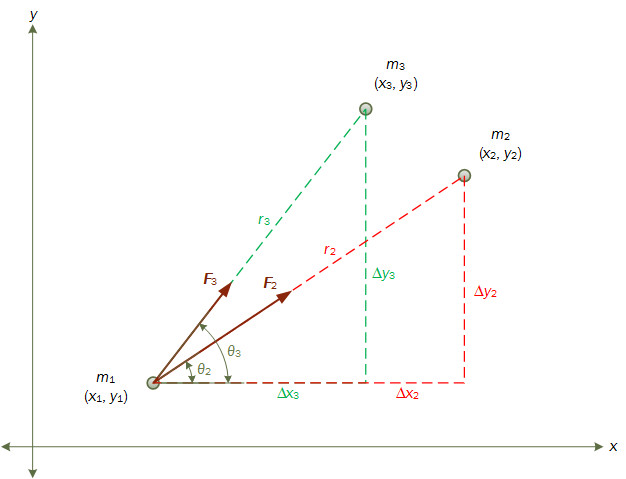
Сначала заметим, что результирующая сила F₁, действующая на тело m₁, будет суммой сил F₂ и F₃. Это значит, что F₁ = m₁a₁ = F₂ + F₃.
Теперь по тригонометрическим законам, мы можем разложить модуль результирующей силы F₁, действующей на тело m₁, на компоненты x и y:

В красном и зеленом треугольниках на рис. мы видим:
Согласно закону всемирного тяготения Ньютона, F₂ и F₃ можно выразить как:

Подставляя формулы, получим:
Эту систему уравнений (34,35,38-41) можно решить численно методом интегрирования "чехарда" (формулы 22–24) по заданным начальным условиям (значения массы, положения и скорости для каждого тела) с приемлемой точностью и стабильностью. Чтобы быстро добиться высокой точности, можно использовать рабочий веб-процесс для выполнения численного интегрирования в потоке, отдельном от потока пользовательского интерфейса главной страницы.
Рассмотрим N небесных тел. Пусть i обозначает одно из тел (i = 1, …, N), а h — малый интервал времени. В позиционном алгоритме Верле следующие значения положения и скорости тела i вычисляются следующим образом:

номера возле формул соответствуют номерам формул в программе(см.текст программы K3.js)
firekeepers casino <a href="https://onlinecasinodd.com/">zone online casino games</a> free slots games <a href="https://onlinecasinodd.com/">online casino gambling</a> | https://onlinecasinodd.com/ - free online casino https://onlinecasinodd.com/ - firekeepers casino
Ссылки по теме
- Физические законы и формулы для задачи двух и трех тел.
- Овалы Кассини и лемниската- Курс высшей математики, Т.1
- «Гравитация» А. Н. Петров
